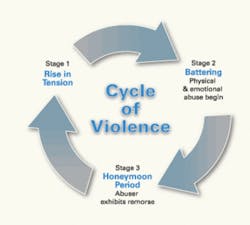End the cycle of violence
The first part of this series discussed the unspoken traits of abusers and the different types of domestic violence. Being familiar with these steps provides the awareness required for Part 2, as this intense cycle of abuser control and manipulation is discussed. Once domestic violence is discovered, addressing the issue and arriving at a solution becomes vital for employers to provide a safe and healthy work environment for both employees and patients.
By Anastasia L. Turchetta, RDH, and Teresa Duncan, MS
Domestic violence victims often experience a three-part cycle during abuse. The silent suffering occurs during the second stage, which is battering. Clues to the victim's situation are most often evident during this and the third stage, the honeymoon period (see Figure 1).
When a victim is in the battering phase, the external clues can be seen in the form of bruises, burns, or unexplained soreness. The emotional withdrawal is also particularly evident, especially if the abuse is new. The honeymoon period will be a relief to the victim, who may say such things as, "He was just going through a phase, he's OK now," or "He's never been so attentive." Over time, the cycle shortens – what used to occur over a few months now manifests itself within weeks or days.
Domestic violence is an issue that no employer can afford to ignore because it impacts all members of the organization, including managers, employees, patients, and clients. In fact, a majority of employee assistance program (EAP) providers surveyed have dealt with partner abuse scenarios in the past year, including an employee with a restraining order (82 percent), and an employee being stalked at work by a current or former partner (71 percent). In addition, businesses pay an estimated $3 to $5 billion annually in medical expenses associated with domestic violence, not including lost wages for absenteeism and reduced productivity.1
The Gentle Approach To A Victim
As an employer or co-worker, what can you do if you suspect abuse? You can approach the subject gently. It is very unlikely that the victim has acknowledged that he or she is a "victim." A productive and driven employee may change into a very scared person right before your eyes. Every individual has a right not to feel fear or intimidation, so communicate this to your co-worker.
Conversation starters can include:2
- I'm scared for your safety (there have been marks on your arm, etc.). Is there anything I can do to help?
- I'm worried about the safety of your children.
- When you're ready, I'm here for you.
- I've noticed you've taken some time off.
- I've noticed lately that you seem distracted.
The actions and behavior of one person have a greater impact on a small dental office than on a large corporation, as the safety of patients and co-workers may be at more risk due to the easy accessibility to the victim by the abuser. Not only is addressing suspected domestic violence essential to maintaining workplace balance, it is required by occupational safety and health laws.
When designing a policy for your practice, research laws such as victim assistance, antidiscrimination, family leave and unemployment. Realize that training employees in these areas is pivotal to the success of the program. For example, a training session may address what indications to watch for, or what to document and who to contact. Indications include a co-worker's or patient's intense anxiety, bruising, or extreme distractedness on the job or in the chair. The Centers for Disease Control estimate that productivity lost due to domestic violence is almost $2 billion.3 Coupled with the paid medical expenses borne by businesses, the cost of domestic violence is enormous. But reaching out is not just good business sense — it's the moral thing to do.
Because the abused already suffers from trust issues at home, confidentiality in the workplace is imperative. The employer should build upon available references when implementing an office policy regarding what constitutes a life-threatening situation for an entire work environment, and act accordingly. The employer should discreetly recommend that the employee seek assistance through state or local agencies. Many organizations dedicate their services specifically to victims of abuse and provide support groups. Do not underestimate the positive power of support groups that consist of family, friends and co-workers.
If you recognize yourself in this article, know that you are not alone. Find resources and share your story with a support group outside of your work environment. The challenge is to fully understand the phases and behaviors of abuse and acknowledge that you may have considered this a "normal" part of daily life. This recognition can become a catalyst for repositioning your life by ending the cycle of abuse. The next step is to not only survive, but thrive. Domestic violence is a topic that warrants discussion and action — silence is not an option.
About the Authors
Anastasia L. Turchetta RDH, is a national and international speaker/author and coach. Empowerment and education via a no sleep atmosphere are granted for the audience, which promote her quest for a team centered; patient focused atmosphere. She maintains memberships with NSA, SCN, ADHA and ADA. She is a feature author in Conversations of Health and Wellness and creator/author of "Just a Cleaning?" an interactive Assisted Hygiene Guide, a unique collaboration of both her 19 years of clinical hygiene experience and coaching format. She may be contacted at www.anastasiardh.com.
Teresa Duncan has a master's degree in health care management from Marymount University. In addition to empowering team members to shine, she also speaks on the topic of fraud and embezzlement within the dental office. She is an educator for the Association of Dental Implant Auxiliaries. You can read her blog at www.thedentalimplantblog.com. Teresa can also be contacted at [email protected].
References
- From The Family Violence Prevention Fund, available online: http://endabuse.org/programs/workplace/
- From The Domestic Violence Handbook, available online: http://www.usda.gov/da/shmd/aware.htm
- From Centers for Disease Control and Prevention press release: http://www.cdc.gov/od/oc/media/pressrel/r030428.htm
Elder Abuse
Incidences of reported elder abuse cases rise every year. The most frequent perpetrator of this crime is the adult child of the abused. In our practices we are uniquely positioned to identify these victims. Common factors found in elder abuse cases:
- The victim is financially dependent upon the abuser
- The level of assistance required by caregiver is high due to the elder's health condition (e.g. disability or dementia)
- The caregiver's stress level is high
Elder abuse is similar to child abuse in that the abuser takes advantage of the dependent nature of the victim. While physical manifestations of abuse can be visibly noted, the emotional toll is harder to measure. Signs of elder abuse can include:
- Change in behavior — a patient that was previously upbeat is now sad and uncommunicative
- Bruises, broken bones or burn marks
- Extreme oral and personal hygiene neglect — we often see this when an elderly patient is brought in for emergency dental care
Contact your local Adult Protective Services department for more information or report a suspected case. Visit The National Center on Elder Abuse website for more information: www.elderabusecenter.org
"The 2004 Survey of State Adult Protective Services:
Abuse of Adults 60 Years of Age and Older" found online: http://www.ncea.aoa.gov/NCEAroot/Main_Site/pdf/2-14-06%20FINAL%2060+REPORT.pdf
To read part one of artcle click here.

